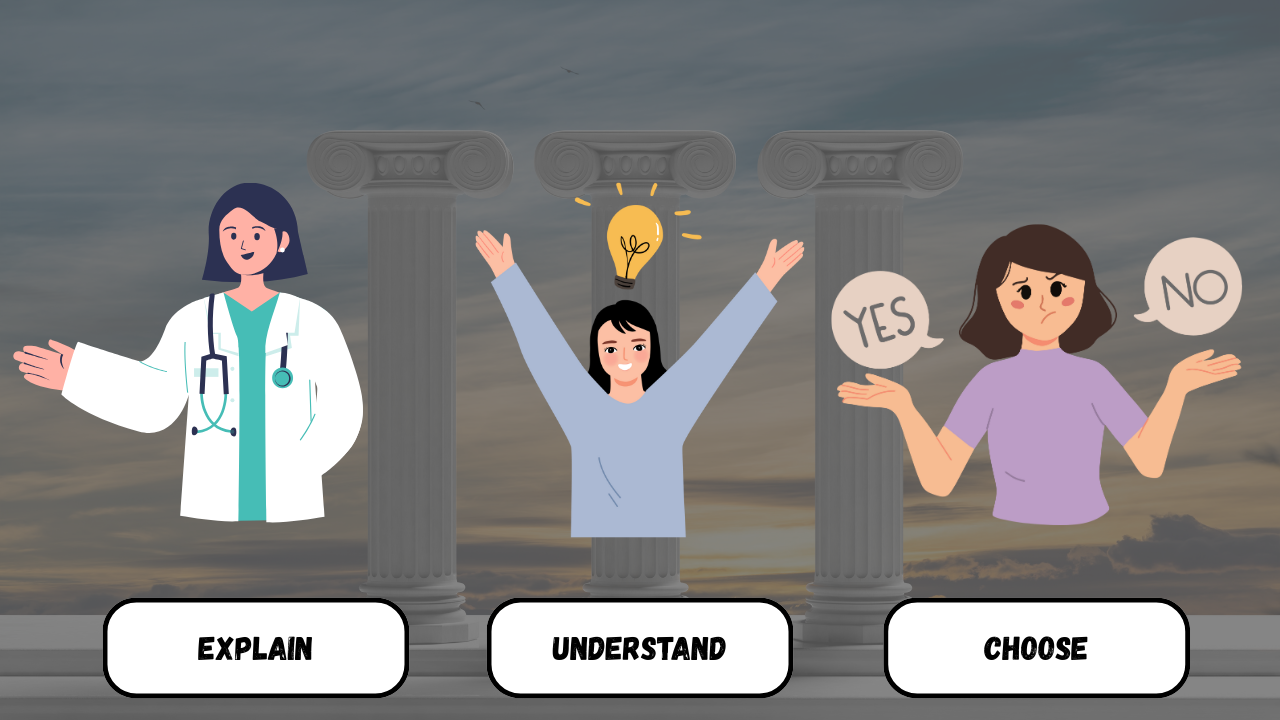It is not uncommon to find yourself seated in a doctor’s office, the scent of antiseptic in the air, anxiously contemplating your upcoming procedure. Your thoughts race: ‘Is this the right choice? What are the risks? These questions fade, however, because the doctor has just given you a form to sign. But do you truly understand what’s about to happen? Are you fully aware of what you’re agreeing to?
Informed consent ensures that you have a clear understanding of the risks, benefits, and alternatives of a given procedure, treatment, or surgery before signing for ‘consent.’ It isn’t just about signing a form—it’s the foundation of trust between you and your doctor, respecting your right to make choices about your body and ensuring that healthcare is ethical and patient-focused.
Understanding patient informed consent is crucial, whether you’re a patient attempting to navigate your treatment options or a medical professional dedicated to prioritizing patients. In this comprehensive guide, we’ll explore what informed consent is, why it matters, the challenges it faces, and what the future holds. This blog will help you approach informed consent with confidence and clarity by providing practical examples, expert insights, and both historical and modern perspectives.
What is Patient Informed Consent?
Defining informed consent, it can best be described as a collaborative process whereby healthcare providers supply a patient with all the relevant details of a treatment or procedure, including its rationale, possible adverse effects, benefits, risks, and alternatives so that the patient can make an informed decision to accept or reject the treatment. It’s more than just signing a form; as outlined in the AMA’s Informed Consent Code of Ethics, it requires that patients have a clear understanding of the information provided and the autonomy to choose.
A Brief Historical Journey

Informed consent evolved from medical ethics with a core principle of respecting individuals, but legal battles were necessary to establish its place in healthcare.
- In 1914, the case of Schloendorff v. Society of New York Hospital solidified adults’ rights to bodily autonomy.
- In 1972, Canterbury v. Spence set a new standard by ruling that providers must give sufficient information to patients for them to make informed decisions about their treatment.
These milestones transformed informed consent from an ethical guideline into a legal and moral obligation.
The Three Pillars of Informed Consent

Informed consent is only valid when three core components are met:
- Full Disclosure: Providers must clearly explain the procedure, its necessity, risks (e.g., infection or complications), benefits (e.g., improved health), and alternative options (e.g., conservative treatments or no treatment). Information must be clear and concise without overwhelming the patient.
- Patient Comprehension: Simply providing information isn’t enough; patients must understand it. Healthcare providers can ensure this through plain language, visual aids, and ask questions such as: “Can you explain in your own words what this procedure involves?”
- Voluntary Decision-Making: Patients should never feel pressured to make a decision by their doctor, relatives, or circumstances. The choice must be theirs alone.
Informed consent isn’t a one-and-done moment. It’s a dynamic conversation that evolves with a patient’s care, ensuring they remain informed every step of the way.
Why Informed Consent is Crucial?
Filling out forms for consent is not merely a bureaucratic requirement. It is one of the key pillars sustaining trust within our healthcare system. Here’s why informed consent is essential:
- Empowering Patient Autonomy: Regardless of societal or institutional influence, individuals have the right to make decisions about their own bodies, including the choice to accept or refuse treatment. Informed consent respects this fact by permitting self determination with the decision, triggering patient decision making – for instance, a patient may elect for palliative care instead of aggressive treatment, and this choice must be respected.
- Building Trust: Transparency builds trust, strengthening the patient-provider relationship. Research suggests that patients who trust their healthcare providers are more likely to adhere to treatment plans and experience higher satisfaction.
- Legal Protection: For patients, informed consent reduces the risk of unexpected outcomes. For healthcare providers, Proper documentation of informed consent protects against litigation and supports thorough professional liability planning. It serves as a safeguard for both parties.
- Better Health Outcomes: Research shows that engaged patients—those who understand and agree to their care—tend to have improved recovery rates and higher satisfaction.
A study published in The BMJ in 2018 associated shared decision-making with improvement in the management of chronic diseases.
Ethically, informed consent aligns with core principles:
- Beneficence: Acting in the patient’s best interest.
- Non-Maleficence: Avoiding harm through transparency.
- Justice: Ensuring equitable access to information for all patients.
In the absence of informed consent, healthcare becomes increasingly paternalistic; decisions shift from dialogue to monologue. This is a past we’ve worked hard to leave behind.
Types of Consent in Patient Care
The involvement of patients in healthcare processes and procedures with prior knowledge and approval requires consent for an intervention or treatment to proceed. Consent of different kinds exists, and it can be divided into varying types:
-
Implied Consent
- What it is: A person’s consent that is believed to be granted given their behavior or certain actions.
- When it applies: Used for routine, non-invasive procedures where cooperation implies agreement.
- Example: Rolling up a sleeve for a blood pressure check or opening your mouth for a throat examination.
- Note: This is sufficient for minor, low-risk actions but not for complex treatments.
-
Explicit (Express) Consent
- What it is: Consent given either verbally or in writing for more complex or risky procedures requires deeper rationale and is more intrusive.
- Forms:
- Verbal Consent: Spoken agreement, often for less invasive treatments.
- Example: Accepting a planned flu shot after discussing it with your doctor.
- Written Consent: Preferably signed by the patient, these documents outline surgical procedures, risks, and benefits to ensure informed decision-making.
- Example: Signing forms before surgery at which time the signer is given an outline of the surgery’s various risks alongside its potential benefits.
- Note: For legal reasons and documentation, Written Consent is preferred.
-
Surrogate (Proxy) Consent
- What it is: An individual’s choice given by someone else (for example, a person is unconscious or mentally unable to make choices) as a result of lacking that individual’s consent.
- When it applies: This comes into play during emergencies or when a patient isn’t able to make decisions for themselves.
- Example: A family member consents to surgery for someone who was in an accident and is unconscious.
- Note: A surrogate should prioritize the patient’s wishes and best interests, often relying on advance directives for guidance.
-
Informed Refusal
- What it is: This refers to when a patient decides not to go ahead with medical treatment after they’ve been provided with all the relevant information about the risks, benefits, and alternative options.
- When it applies: It applies in any case where a patient chooses to decline suggested care.
- Example: Refusal to participate in chemotherapy treatment after being educated on side effects and possible outcomes.
- Note: Such decisions take into account the sovereignty of the patient’s decision and choice.
Why This Matters
Such forms of consent guarantee that the patients and/or their representatives are aware and actively engaged in their care. Consent can take different forms whether it is assumed for regular examinations, stated for operations, substituted for emergencies, or through informed refusal if they choose not to be treated. A basic premise of all these is that consent is given freely and is informed.
Real-World Examples of Informed Consent
Almost every interaction with a healthcare professional requires informed consent; let us consider a few practical scenarios:
- Surgery: A patient facing a knee replacement needs a full briefing: the surgery’s goal (pain relief, mobility), risks (infection, blood clots), benefits (better quality of life), and alternatives (physical therapy, injections, or delaying surgery). The surgeon might use a model knee to illustrate the process.
- Clinical Trials: Someone joining a cancer drug trial must know it’s experimental, understand potential side effects (nausea, fatigue), and be assured they can leave the trial anytime. Clear consent here is critical given the uncertainties.
- Diagnostics: Before a lung biopsy, the patient should learn about the needle insertion, possible discomfort, risks (bleeding, lung collapse), and the chance of inconclusive results requiring further tests.
- Medications: Starting chemotherapy? The oncologist should explain its purpose (shrinking tumors), common side effects (hair loss, immune suppression), and how it integrates with other treatments like radiation.
History offers key lessons, such as the case of Canterbury v. Spence, where a patient sued after spinal surgery left him paralyzed, arguing he was not informed of the risks. The court sided with him, which further strengthened the point that service providers need to give greater emphasis to disclosure instead of relying too much on what patients are presumed to be capable of.
Challenges and Complexities in Obtaining Informed Consent
Though informed consent may seem straightforward in theory, real-world complexities often arise. Here are a few challenges—along with some ideas to solve them:
- Patient Incapacity: If a patient is unconscious (e.g., after a car accident) or suffers from severe dementia, they cannot provide consent. Typically, the husband/wife or adult child of someone begins to make decisions on their behalf; these are called substitute decision makers. If other family members do not agree or if the patient’s wishes are not straightforward, problems might arise. How should one mitigate this? Advance directives or living wills specify particular choices and consequently clear up any ambiguity later on.
- Emergencies: When someone is having a heart attack, there isn’t much time for lengthy discussions before taking action. Healthcare providers rely on “implied consent” to rescue the patient but should explain things afterward. It’s essential to strike the right balance between acting quickly and being transparent.
- Cultural and Language Barriers: A patient who doesn’t speak English might nod their head in agreement even if they don’t really understand what’s being said. Consent can also get complicated due to cultural dynamics. To bridge these gaps, using qualified interpreters and tailored educational materials, like videos in the patient’s language, can be really effective.
- Minors: For young children, decisions are made by parents. But teenagers, like 16-year-olds, can understand sophisticated procedures such as chemotherapy. There is variation in law – some jurisdictions permit consent from “mature minors” – So it is important to include them in conversations to enhance trust and foster independence.
Legally, exceptions and standards complicate things:
- Exceptions: Formal consent could be waived during emergencies or due to incapacity.
- Disclosure Standards: Some areas use the reasonable patient standard (what a typical patient needs to know), and others use the reasonable physician standard (what is customary for doctors to share). Each provider must understand the relevant boundaries.
The Role of Technology in Informed Consent
Technology is revolutionizing how we approach consent, offering both opportunities and challenges:
- Telemedicine: Virtual appointments provide convenient access to medical care; however, consent must explain the boundaries of remote care, such as the absence of a physical examination. To mitigate risks related to Telemedicine Malpractice, providers might send a form via email or explain the potential limitations and risks over a video call, where patients are given verbal space to express themselves.
- Digital Tools: E-consent platforms can embed videos (e.g., a 3D animation of surgery) or quizzes (“What’s the main risk of this procedure?”) to boost understanding. The catch? Not all patients have reliable internet or tech skills—hospitals must provide support like in-person guidance.
- Artificial Intelligence: AI can review a patient’s medical history and tailor the consent information to highlight what’s most relevant to that individual—like pointing out the risks of surgery for someone with diabetes. However, machines don’t possess empathy, which is why having human oversight is crucial to keep the process both compassionate and precise.

There’s a clear optimism around technology, but it’s vital that we also ensure clarity and accessibility, making sure no one is left out in the process.
Best Practices for Healthcare Providers
Providers ensure that informed consent is given properly. Here is what makes it respectful and thorough:
- Communicate Clearly: Ditch the jargon—“heart attack” beats “myocardial infarction” every time. Use analogies (e.g., “This stent is like a tiny scaffold for your artery”) and the teach-back method (“What do you think this surgery will do?”) to confirm understanding.
- Document Everything: Capture details on all patient interactions. This includes the whole dialogue, the questions, and how the patient responded and showed understanding. Think of it not only from a legal point of view. Consider it a framework in case a different modality of care arises.
- Keep It Ongoing: Consent is not a one-time thing. If there is a change to a patient’s chemotherapy regimen as a result of some side effects, that conversation needs to happen again. Putting in the effort to follow up demonstrates respect and a willingness to change.
- Train Continuously: Legal briefs, cultural training, and communication workshops can sharpen skills. Simulation of difficult situations, like grieving family members who disagree with a patient, builds even more confidence.
Steps to Secure Consent:
- Outline the steps, possible risks, benefits, and other options in simple language.
- Encourage questions and explain further as necessary.
- Collect consent that may be tacit (such as extending an arm for a vaccination), spoken, or written.
- This has to be done by the provider who is responsible for the patient—not a nurse or aide—so there is ownership and trust.
Empowering Patients: What You Can Do
Engagement is a two-way street, as patients play an important part. Here’s how you can actively participate:

Ask Questions: Don’t hesitate. Try, “Can you break that down simpler?” or “What would you choose if it were you?” Providers welcome curiosity—it shows engagement.
Seek Second Opinions: Another doctor’s perspective can certainly clear up doubts around available options. It is their right, and good providers encourage it.
Know Your Rights: You can say no or change your mind—even mid-treatment. If you’ve agreed to surgery but feel uneasy in pre-op, speak up. Your team should support, not judge.
Proactivity turns informed consent into a tool for self-advocacy, ensuring that your care reflects your values.
The Future of Informed Consent
Just as the healthcare sector is continually changing, so is informed consent. Here’s what is to come:
- Personalized Medicine: As treatments target genetic profiles (e.g., cancer drugs for specific mutations), consent will need to tackle nuanced, patient-specific risks and benefits. Anticipate more detailed and personalized conversations centered around consent.
- Shared Decision-Making: This model facilitates coordination by having patients and their providers consider options together, aligning care with goals, such as prioritizing quality of life instead of lifespan. It is consent as collaboration.
- Technological Advances: Blockchain may safeguard records of consent by making them transparent and unalterably authenticated, while virtual reality (or its potential future iterations) could allow patients to ‘experience’ a procedure beforehand.
However, innovations and education, if combined, may bridge the gap of cultural differences and literacy skills. These barriers may be persistent, but inclusiveness and enhanced effectiveness of consent frameworks can be achieved.
Informed consent is more than a form—it’s a patient’s right and a provider’s duty. By fostering clear communication, ensuring comprehension, and respecting autonomy, healthcare professionals can build trust and improve patient outcomes.
Understanding and implementing Patient informed consent correctly ensures that every medical decision is a shared one, rooted in transparency, respect, and ethical responsibility.









